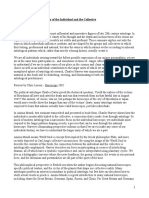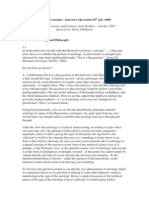House Systems
House Systems
Uploaded by
smankarious2005Copyright:
Available Formats
House Systems
House Systems
Uploaded by
smankarious2005Original Description:
Copyright
Available Formats
Share this document
Did you find this document useful?
Is this content inappropriate?
Copyright:
Available Formats
House Systems
House Systems
Uploaded by
smankarious2005Copyright:
Available Formats
HOUSE SYSTEMS: Differences Between Them
An Information Special from Astro Communications Services, Inc.
House systems are methods of dividing the sphere into 12 parts. Quite a lot of controversy exists among astrologers as to which of several methods works the best or if, indeed, any of them work! (The latter point of view is generally held among Cosmobiologists, who study charts primarily on a 90 dial which ignores house positions entirely.) Placidus The majority of astrologers in the English-speaking world use the Placidus house system, but this is not because it has been proven best, but rather because the Placidus system was the first one to be widely published and therefore got the inside track. It was invented in the 17th century by an Italian monk, Placidus de Titus, and became popular in English-speaking countries with the annual publication of Raphaels Almanac, which included Placidian tables. Books that include Placidus house tables are still the most easily and inexpensively available in most places. Therefore they have been widely used over the years by astrology teachers who, of course, tell their students to use them, thus perpetuating their popularity. Some astrologers would disagree with the observation that the Placidus system is unproven, because the Gauquelin research (one of astrologys only claims to statistical proof) puts forth sectors that are closely akin to Placidian houses. This is undoubtedly a point in favor of Placidus, but nevertheless, we dare say that the majority of people use Placidus houses merely because of our first reason given above, rather than the latter. In the Placidus system the house cusp curves are formed by points each of which trisects its own diurnal or nocturnal semi-arc. If you are not familiar with spherical astronomy, that definition is probably, shall we say, less than clear, but a detailed description of this complex exercise in mathematics is beyond the scope of this Information Special. For now, important facts to point out are: 1. It is an unequal house system, resulting in interceptions in some locations (see also Information Special IIHX Intercepted Signs: Why All Houses Arent Equal); 2. The Midheaven is the cusp of the 10th house and the Ascendant is the cusp of the first house; 3. The system gets very weird near the polar regions over half the zodiac signs can be intercepted (not appearing on any cusp); and finally (but very important that you know) 4. The Placidus system is Astros computer default if you dont specifically request an alternate system when you order, Placidus is what you will get! (Majority rules.)
IHSX
Koch In the Koch system only the diurnal semi-arc of the MC is trisected. The MC is then rotated backwards through its diurnal semi-arc to the horizon to determine the 11th house cusp, and then again to determine the 12th and so on. The Koch system (first published, though not invented, by Dr. Walter Koch, 1895-1970) originated in Germany, home of the Uranian and Cosmobiology schools, so if a Cosmobiologist looks at houses at all, they will no doubt be drawn in the Koch system. This is the next most popular system after Placidus, and is the choice of this author (whose technical specialty is Uranian/Cosmobiology) not because anyone has satisfactorily proven its superiority to me, but merely because I like my own chart best in the Koch system. (And believe me, for most astrologers, this is the only honest answer!) Joyce Wehrman, whose system of Winning Transits is offered through Astro (see Information Special IWINX), was a strong advocate of Koch houses, and Koch house cusps are an important part of her Winning system. Equal Astros third most frequently ordered house system is Equal Houses. No doubt this is because a significant number of people prefer to avoid the whole controversy of dealing with interceptions and unequal houses. Here the ecliptic is divided into twelve equal houses by lunes (think of lunes as sort of like 12 sections of an orange) whose poles are those of the ecliptic itself. The Ascendant is the cusp of the first house, and each successive house cusp is then the same degree of the next sign. The Midheaven rarely winds up on the 10th house cusp and instead usually falls somewhere in the 9th or 10th house. This system is said to have been used in India around 3000 BC (and is still used there today), so it takes the prize for antiquity, so far as we know. Of the other house systems we offer, none are ordered in any great volume, but each has its strong advocates, so that is why we make them available. Soin no particular order: Meridian Here the MC is the cusp of the 10th house and the East Point or Equatorial Ascendant (whichever you prefer to call it) is the cusp of the 1st house. (The East Point is defined in Information Special IXBX, which covers the freebies you can request on your basic charts). The equator is divided into 12 almost equal arcs by lunes from the poles of the celestial equator, and the intersections of the lunes with the ecliptic are the house cusps. This system is fairly widely used among Uranian astrologers.
Astro Communications Services, Inc. 5521 Ruffin Rd, San Diego, CA 92123 858 492-9919
Campanus This system divides the prime vertical into 12 equal arcs by lunes whose poles are the north and south points of the horizon. The house cusps are the degrees at which the lunes intersect the ecliptic. As with other unequal house systems, there is extreme distortion at birthplaces far from the equator. Two brothers, Joseph and Matthew Campanus, who lived in the late 15th century, may have originated this system, but it is also possible that it dates back to the 13th century. This system has had strong support from a number of famous astrologers; notably, Dane Rudhyar and Charles Jayne. Regiomontanus Here we have the celestial equator divided into 12 equal segments beginning at the East Point, and lines perpendicular to the prime vertical drawn through the points of division and projected onto the ecliptic as house cusps. This system is identical to Campanus for birthplaces on the equator, and like Campanus it gets extremely distorted in the polar regions. It was invented in the 15th century by a German astronomer whose name, of course, was Regiomontanus. Alcabitius This one dates back to at least the 1st century AD, and is the one used in the few surviving examples of Greek horoscopes. The Ascendant is the first house cusp, and from there house cusps are determined by means of trisecting the diurnal semi-arc. A point in favor of this system is that even though it is unequal, it does not fall apart in polar regions. But at certain birthtimes, there can be a large variation in house size, no matter what the latitude. Porphyry Attributed to a Neoplatonist named, of course, Porphyry, this system dates from the 3rd century AD. The Midheaven is the cusp of the 10th, the Ascendant is the cusp of the 1st, and intermediate houses divide each quadrant equally as measured on the ecliptic. As with many of the others, you get very strange distortions in polar regions. Topocentric This one is considerably different in that it was derived empirically, rather than from mathematical theory. Its theoretical basis was formulated after empirical evidence for house cusps was gathered through the study of primary directions. It was introduced in the 20th century by two Argentine astrologers, Wendel Polich and Anthony Nelson Page. Its cosmography is topocentric rather than geocentric, meaning that the birthplace remains on the surface of the Earth, rather than being projected to the center in order to take advantage of the great circles of the celestial sphere. It is interesting that although the mathematical basis for this
system is entirely different, it produces cusps that are within 1 of the Placidus cusps up to about 56 north or south latitude. Avid proponents of the system would say that this is not enough, for primary directions to topocentric cusps work within very few minutes of arc. Those interested in exploring this system might like to order Dr. Margaret Millards The Genetics of Astrology: A Study of the Topocentric System, which demonstrates these extremely close primary direction hits through fascinating case studies of members of her family. (B209X $9.95)
Recommended Reading Those who are interested in much more detailed and technical explanations of these house systems than are given here should write to Mary Downing, Executive Secretary of NCGR, P.O. Box 1220, Dunkirk, MD 20754-9998, (or call (301) 731-5954) and inquire about getting copies of the technical articles from the Winter 1988-1989 NCGR Journal. That issue contains an excellent Astrological House Formulary by Michael Munkasey, and a wealth of other articles by Dr. Millard and by other prominent technical astrologers, that are sure to be an intellectual feast for anyone interested in astrological mathematics and computer technology. Much of the material in this issue is just not available from other sources. Other Information Specials that relate to this one: IHSCX House Systems: How to Choose One IIHX Intercepted Signs: Why All Houses Arent Equal And a way to compare all of the house systems according to the most important measurement your chart: House Comparisons This one page Add-On calculation option lists all house cusps (degrees and minutes) for all nine of the different systems that have been described in this Information Special. Or, since some of our options do require that you order a basic natal chart in order to get them, why not request a different house system every time you get your chart until you have all nine? Then you can line them all up and consider the differences according to your own personal frame of reference. But remember if you dont request an alternative at the time you place your order, your charts will come in Placidus. Exceptions to this are our regular customers, who, if they request, may have an alternate house system specified in their accounts as a personal standard default to be automatically used every time they order.
Astro Communications Services, Inc. 5521 Ruffin Rd, San Diego, CA 92123 858 492-9919
You might also like
- Pentacles of SolomonDocument21 pagesPentacles of SolomonJoseph Burns100% (6)
- Vocations The New Midheaven Extension ProcessDocument266 pagesVocations The New Midheaven Extension ProcessMiss M.100% (28)
- Astrology Language of Life Volume 1 Progressions-Robert P BlaschkeDocument137 pagesAstrology Language of Life Volume 1 Progressions-Robert P Blaschkea90% (10)
- Mapping The PsycheDocument1 pageMapping The PsycheViviana Puebla0% (6)
- Working With SOLAR RETURNSDocument22 pagesWorking With SOLAR RETURNSPongwuth100% (19)
- Managerial Economics Baye Solutions (3-5)Document36 pagesManagerial Economics Baye Solutions (3-5)Rahim Rajani77% (22)
- Midheaven Extension ProcessDocument11 pagesMidheaven Extension ProcessSharon Wilson86% (7)
- Astrology in the Workplace: The Zodiac Guide to Creating Great Working RelationshipsFrom EverandAstrology in the Workplace: The Zodiac Guide to Creating Great Working RelationshipsNo ratings yet
- Robert Hand 97Document18 pagesRobert Hand 97Raquibun Nabi Ratul100% (2)
- AsteroidsDocument2 pagesAsteroidssmankarious2005100% (2)
- Raphael's Horary Astrology by which Every Question Relating to the Future May Be AnsweredFrom EverandRaphael's Horary Astrology by which Every Question Relating to the Future May Be AnsweredNo ratings yet
- Noel Tyl - The Quindecile AspectDocument2 pagesNoel Tyl - The Quindecile AspectValentin Badea100% (3)
- Planetary ThreadsDocument2 pagesPlanetary ThreadsViviana PueblaNo ratings yet
- Robert Hand Whole Signs Houses AstrologyDocument28 pagesRobert Hand Whole Signs Houses Astrologyshadowgraph100% (5)
- The Astrological Aspects by Charles CarterDocument70 pagesThe Astrological Aspects by Charles Cartertratak93% (30)
- AFA BooksDocument35 pagesAFA Booksthe.housecatNo ratings yet
- The Moon - Frank CliffordDocument12 pagesThe Moon - Frank CliffordAlexandra Condeco Pinto100% (3)
- Barbara H. Watters - Horary Astrology and The Judgement of Events PDFDocument226 pagesBarbara H. Watters - Horary Astrology and The Judgement of Events PDFyuorme90% (10)
- Electional Astrology by Mary Fortier Shea, M.A. Counseling PsychologyDocument6 pagesElectional Astrology by Mary Fortier Shea, M.A. Counseling Psychologyvamshik.tulasi696No ratings yet
- A Rectification Manual - ExampleDocument41 pagesA Rectification Manual - Examplesorobanista100% (1)
- Anima MundiDocument2 pagesAnima MundiViviana Puebla100% (1)
- American Federation of Astrologers Inc Astrology Books CatalogueDocument35 pagesAmerican Federation of Astrologers Inc Astrology Books CatalogueReiki Master100% (1)
- The Astrological Aspects by Charles CarterDocument5 pagesThe Astrological Aspects by Charles CartertratakNo ratings yet
- Hellenistic Astrology Table of ContentsDocument6 pagesHellenistic Astrology Table of ContentsJoana Erika PillejeraNo ratings yet
- Geoffrey Cornelius InterviewDocument19 pagesGeoffrey Cornelius InterviewClélia RomanoNo ratings yet
- Lilly, William - ObservationsDocument29 pagesLilly, William - Observationsshadowgraph100% (1)
- Timing The Circle Astrology Noel Tyl PDFDocument513 pagesTiming The Circle Astrology Noel Tyl PDFyuorme89% (9)
- Corre Primacy of The AscendantDocument5 pagesCorre Primacy of The AscendantmilithebillyNo ratings yet
- Senior Extension Astrology Course 1-13Document35 pagesSenior Extension Astrology Course 1-13tsampounasNo ratings yet
- Alan Oken Mutual Reception PDFDocument6 pagesAlan Oken Mutual Reception PDFnaveen100% (1)
- Essential Dignity TableDocument1 pageEssential Dignity TableinterglossarsNo ratings yet
- John Frawley All Articles Published in The Considerations MagazineDocument65 pagesJohn Frawley All Articles Published in The Considerations MagazineJoão SilvaNo ratings yet
- The Principles of AstrologyDocument3 pagesThe Principles of AstrologyShajar Romero0% (2)
- Twelfth Parts and The Astrology of ProfessionDocument9 pagesTwelfth Parts and The Astrology of ProfessionMihaela DicuNo ratings yet
- When Will I Get Married UAC2012 April Elliott Kent PDFDocument61 pagesWhen Will I Get Married UAC2012 April Elliott Kent PDFMia Bukovsky100% (1)
- Your Dangerous AgeDocument8 pagesYour Dangerous AgeemineNo ratings yet
- Considerations - 19-1Document99 pagesConsiderations - 19-1Mihaela Dicu100% (2)
- Tyl - Organizing Your Measurements MeaningfullyDocument9 pagesTyl - Organizing Your Measurements Meaningfullytsampounas100% (2)
- Darby Costello, The 4 ElementsDocument165 pagesDarby Costello, The 4 ElementsHugo Rafael Chávez0% (2)
- Lee Lehman - Void of Course MoonDocument8 pagesLee Lehman - Void of Course MoonJohnette Ricchetti100% (3)
- The Journal of Psychological AstrologyDocument3 pagesThe Journal of Psychological Astrology99manu9950% (2)
- Scofield ElectionalDocument4 pagesScofield ElectionalDorotheus100% (2)
- Astrologys MirrorDocument21 pagesAstrologys Mirrorm.s.subramania sharmaNo ratings yet
- Penny Seator - Morinus MethodDocument17 pagesPenny Seator - Morinus MethodJohnette Ricchetti100% (2)
- A Rectification Manual - ExampleDocument41 pagesA Rectification Manual - ExampleajakukNo ratings yet
- RelocationDocument2 pagesRelocationsmankarious2005No ratings yet
- Astro What Are AspectsDocument11 pagesAstro What Are AspectsThe ManNo ratings yet
- Noel Tyl InterviewDocument9 pagesNoel Tyl Interviewpijani_pauk100% (1)
- Book 1955 - R. C. Davidson - The Technique of Prediction The New Complete System of Secondary DirectingDocument149 pagesBook 1955 - R. C. Davidson - The Technique of Prediction The New Complete System of Secondary Directingantoniorios1935-1100% (4)
- Joyce Levine - A Beginner's Guide To Astrological InterpretationDocument141 pagesJoyce Levine - A Beginner's Guide To Astrological Interpretationalex100% (1)
- Astrology Article Joy UsherDocument4 pagesAstrology Article Joy UshershadowgraphNo ratings yet
- Dennis Elwell интервьюDocument8 pagesDennis Elwell интервьюgwinpin32100% (1)
- Sky View Zones Course On Basic Natal Astrology - Anne MogulDocument289 pagesSky View Zones Course On Basic Natal Astrology - Anne MogulIvica Matijević100% (3)
- Dynamic Interactive Astrology: Level One - The Planets in Signs and HousesFrom EverandDynamic Interactive Astrology: Level One - The Planets in Signs and HousesNo ratings yet
- Between Astrologers and Clients: The Foundation of a RelationshipFrom EverandBetween Astrologers and Clients: The Foundation of a RelationshipNo ratings yet
- RelocationDocument2 pagesRelocationsmankarious2005No ratings yet
- Health FoodsDocument3 pagesHealth Foodssmankarious2005No ratings yet
- The Sidereal Solar ZodiacDocument3 pagesThe Sidereal Solar Zodiacsmankarious2005No ratings yet
- 1.2 - Unit1 - Proposition, Logical Operators, TruthtablesDocument5 pages1.2 - Unit1 - Proposition, Logical Operators, TruthtablesDr. Sushant ShekharNo ratings yet
- Excel Calculations Excel Calculations: The IGT Distribution Equation For Natural Gas FlowDocument2 pagesExcel Calculations Excel Calculations: The IGT Distribution Equation For Natural Gas Flowleonel TintayaNo ratings yet
- Electronic Class Record - Senior High SchoolDocument80 pagesElectronic Class Record - Senior High SchoolEljay FloresNo ratings yet
- LogicDocument1 pageLogicthephantom096No ratings yet
- COMP1411 Final Exam Question BookDocument10 pagesCOMP1411 Final Exam Question Bookashtonsamuel2121No ratings yet
- Convex MirrorDocument3 pagesConvex MirrorMae Jane AguilarNo ratings yet
- Combine-Footing-By-IS-456-2000 - 1Document33 pagesCombine-Footing-By-IS-456-2000 - 1V.m. RajanNo ratings yet
- ME 563 Mechanical Vibrations Lecture #11: Single Degree of Freedom Free Response (Matlab)Document9 pagesME 563 Mechanical Vibrations Lecture #11: Single Degree of Freedom Free Response (Matlab)nils4586No ratings yet
- Unit 5 Worker - Machine RelationshipsDocument7 pagesUnit 5 Worker - Machine Relationshipsleonard dela cruzNo ratings yet
- Exercise 1.2: Prob. 1 (I)Document3 pagesExercise 1.2: Prob. 1 (I)aftabNo ratings yet
- OverKill 2.1Document5 pagesOverKill 2.1Anthony AyckeNo ratings yet
- Review Module 3 Trigonometry Part 2Document1 pageReview Module 3 Trigonometry Part 2KrishaNo ratings yet
- Linear Equation in Two Variables Can Be Written AsDocument30 pagesLinear Equation in Two Variables Can Be Written Asmahesh prasadNo ratings yet
- Beta Survival Models: David Hubbard, Benoît Rostykus, Yves Raimond, Tony JebaraDocument11 pagesBeta Survival Models: David Hubbard, Benoît Rostykus, Yves Raimond, Tony JebaraJuan Fernando VillegasNo ratings yet
- Functions AlphabeticalDocument6 pagesFunctions AlphabeticalomraviNo ratings yet
- Edifact Syntax Eancom PDFDocument18 pagesEdifact Syntax Eancom PDFyouvsyouNo ratings yet
- Cikuit: Asynchronous DesignDocument14 pagesCikuit: Asynchronous DesigncuickNo ratings yet
- Introduction To Propositional LogicDocument16 pagesIntroduction To Propositional LogicJohn Rod M Balagtas100% (1)
- Math Project For Dealing DownDocument3 pagesMath Project For Dealing Downapi-255620363No ratings yet
- VIC CipherDocument7 pagesVIC Cipherxativiy256No ratings yet
- Iso 11357-4 - 2014 DSCDocument18 pagesIso 11357-4 - 2014 DSCPablo OrtegaNo ratings yet
- Game TheoDocument587 pagesGame TheoVitor Hadad100% (2)
- Chapter 6 ReviewDocument4 pagesChapter 6 ReviewDheepikha ShivakumarNo ratings yet
- AgeandGenderPrediction Batch 27Document12 pagesAgeandGenderPrediction Batch 27AppleNo ratings yet
- NIST-JANAF Thermochemical TablesDocument39 pagesNIST-JANAF Thermochemical TablesVelzaeroNo ratings yet
- Flat Platewitha Hole Analysisby AbaqusDocument7 pagesFlat Platewitha Hole Analysisby AbaqusMuhammad MalikNo ratings yet
- CPS 270: Artificial Intelligence Planning: Vincent ConitzerDocument28 pagesCPS 270: Artificial Intelligence Planning: Vincent ConitzerShubham PattiNo ratings yet
- The Problem and Its Scope: Correlation Between Procrastination and Academic Performance 1Document64 pagesThe Problem and Its Scope: Correlation Between Procrastination and Academic Performance 1Jason DungogNo ratings yet
- Unit 1: Transformations "Translations"Document139 pagesUnit 1: Transformations "Translations"ARNOLD NOVEMRINo ratings yet





























































































